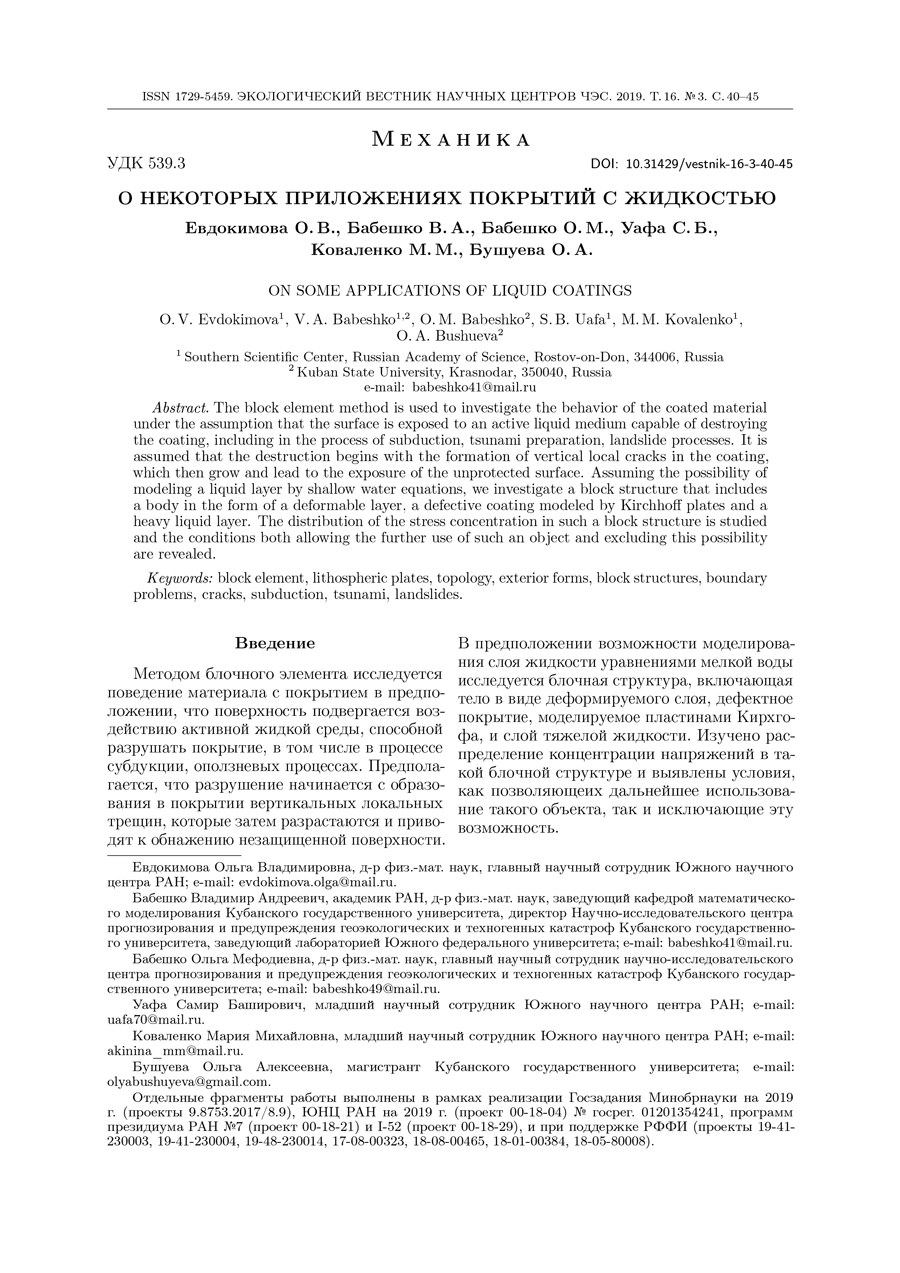On some applications of liquid coatings
UDC
539.3DOI:
https://doi.org/10.31429/vestnik-16-3-40-45Abstract
The block element method is used to investigate the behavior of the coated material under the assumption that the surface is exposed to an active liquid medium capable of destroying the coating, including in the process of subduction, tsunami preparation, landslide processes. It is assumed that the destruction begins with the formation of vertical local cracks in the coating, which then grow and lead to the exposure of the unprotected surface. Assuming the possibility of modeling a liquid layer by shallow water equations, we investigate a block structure that includes a body in the form of a deformable layer, a defective coating modeled by Kirchhoff plates and a heavy liquid layer. The distribution of the stress concentration in such a block structure is studied and the conditions both allowing the further use of such an object and excluding this possibility are revealed.
Keywords:
block element, lithospheric plates, topology, exterior forms, block structures, boundary problems, cracks, subduction, tsunami, landslidesAcknowledgement
References
- Sinclair, G.B. Stress singularities in classical elasticity I. Appl. Mechanics Reviews, 2004, vol. 57, pp. 251–298. DOI: 10.1115/1.1762503
- Sinclair, G.B. Stress singularities in classical elasticity II. Appl. Mechanics Reviews, 2004, vol. 57, pp. 385-439. DOI: 10.1115/1.1767846
- Sator, C., Becker, W. Closed-form solutions for stress singularities at plane bi- and trimaterial junctions. Arch. Appl. Mech., 2012, vol. 82, pp. 643–658. DOI: 10.1007/s00419-011-0580-6
- Kirugulige, M.S., Tippur, H.V. Mixed-mode dynamic crack growth in a functionally graded particulate composite: experimental measurement and finite element simulations. J. Appl Mech., 2008, vol. 75, iss. 5, pp. 051102.
- Zhang, G., Le, Q., Loghin, A., Subramaniyan, A., Bobaru, F. Validation of a peridynamic model for fatigue cracking. Engineering Fracture Mechanics, 2016, vol. 162, pp. 76–94. DOI: 10.1016/j.engfracmech.2016.05.008
- Rangarajan, R., Lew, A.J. Universal meshes: A method for triangulating planar curved domains immersed in nonconforming meshes. Int. J. Numer. Meth. Engng., 2014, vol. 98, iss. 4, pp. 236–264.
- Perelmuter, M. Boundary element analysis of structures with bridged interfacial cracks. Comput. Mechanics, 2013, vol. 51, iss. 4, pp. 523–534.
- Morozov, N.F. Matematicheskie voprosy teorii treshchin [Mathematical issues in crack theory]. Nauka, Moscow, 1984. (In Russian)
- Agrawal, A., Karlsson, A.V. Obtaining mode mixity for a bimaterial interface crack using the virtual crack closure technique. Int. J. Fract., 2006, vol. 141, pp. 75–98.
- Beuth, J.L. Separation of crack extension modes in orthotropic delamination models. Int. J. Fract., 1996, vol. 77, pp. 305–321.
- Bjerkén, C., Persson, C. A numerical method for calculating stress intensity factors for interface cracks in bimaterials. Eng Fract Mech. 2001, vol. 68, pp. 235–246. DOI: 10.1016/S0013-7944(00)00098-9
- Babeshko, V.A., Evdokimova, O.V., Babeshko, O.M. Hidden defects in nanostructures, covering bodies, and seismology. Doklady Physics, 2014, vol. 59, iss. 7, pp. 313–317.
- Babeshko, V.A., Evdokimova, O.V., Babeshko, O.M., Uafa, G.N., Evdokimov V.S. O startovykh zemletryaseniyakh pri parallel'nykh razlomakh litosfernykh plit [On starting earthquakes during parallel faults of lithospheric plates]. Izvestiya Saratovskogo universieta. Seriya: Matematika. mekhanika. Fizika [Bulletin of the Saratov University. Series: Mathematics. Mechanics. Physics], 2018, vol. 18, iss. 4, pp. 370–380. (In Russian)
- Stoker, Dzh.Dzh. Volny na vode. Matematicheskaya teoriya i prilozheniya [Waves on water. Mathematical Theory and Applications]. Inostrannaya literatura, Moscow, 1957. (In Russian)
- Vorovich, I.I., Babeshko, V.A. Dinamicheskie smeshannye zadachi teorii uprugosti dlya neklassicheskikh oblastey [Dynamic mixed problems of elasticity theory for non-classical domains]. Nauka, Moscow, 1979. (In Russian)
Downloads
Submitted
Published
How to Cite
Copyright (c) 2019 Evdokimova O.V., Babeshko V.A., Babeshko O.M., Uafa S.B., Kovalenko M.M., Bushueva O.A.

This work is licensed under a Creative Commons Attribution 4.0 International License.




